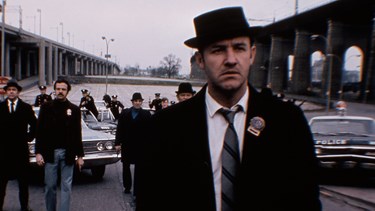
William Friedkin's The French Connection, which won the Academy Award for Best Picture of 1971, is being shown at the Paris Theater in 35mm on December 9, introduced by Jason Bailey. Below is an excerpt from Bailey's book, Fun City Cinema: New York City and the Movies That Made It.
The dread-infused music by Don Ellis that opens Friedkin’s cop classic—horn notes blasted rather than played, sounding less like trumpets than sirens—immediately creates a sense of chaos and terror that permeates all that follows. The movie is similarly impatient; the opening credits barely take time to list the key personnel before we’re tossed into a sting in progress, with Popeye Doyle (Gene Hackman, in an Oscar-winning performance) incognito in a Santa suit, joining his partner Buddy Russo (Roy Scheider) in breathless pursuit of their subject.
“The French Connection marks one of the most ambitious movie projects ever to be filmed in New York City,” boasted the press notes. “Eighty-six separate locations throughout the city were utilized, covering Gotham scenically as it has rarely been before in a feature film.” Friedkin and producer Philip D’Antoni coordinated principal photography between December 1970 and February 1971, because, per D’Antoni, “the winter was when the actual events occurred.” Scenes were shot in Grand Central Station, in Central Park, on Madison Avenue, and on the Lower East Side in Manhattan; in Maspeth and at LaGuardia in Queens; in Bedford-Stuyvesant and Coney Island in Brooklyn; and even at Ward’s Island in the Upper East River.
The precedent set by D’Antoni’s earlier Bullitt was part of the reason The French Connection’s iconic chase existed at all; it wasn’t part of the original police case, or Moore’s book. “I felt challenged to do another kind of chase,” Friedkin wrote, “one which, while it might remind people of Bullitt, would not be essentially similar.” The key difference was vehicular: Bullitt was a car chasing a car, but The French Connection was a car chasing an elevated subway train.
This meant the production had to not only coordinate, as usual, with the mayor’s office, but with the NYC Metropolitan Transit Authority. After some wrangling over the accuracy of the details of the sequence, the MTA granted the production permission to shoot on the Stillwell Avenue line in Brooklyn. Friedkin and his team marked off an ideal stretch from Bay 50th Street to 60th Street, and worked through a plan to shoot the sequence in two chunks (one for the train and one for the car) in bits and pieces over a five-week period—and only between ten a.m. and three p.m., between the line’s rush hours.
To shoot Hackman (and his stunt double, Bill Hickman) driving under the track, Friedkin and cinematographer Owen Roizman mounted three cameras on and inside the car, and used three simultaneous cameras when shooting from the street. “Because we were using real pedestrians and traffic at all times, it was impossible to undercrank, so everything was shot at normal speed,” Friedkin wrote. “In most shots, the car was going at speeds between 70 and 90 miles an hour. . . . We prayed a lot, and kept our fingers crossed.”
The danger of New York City, the noisiness and chaos and disorder that Friedkin so adroitly transformed into tension, could also be cranked by less-graceful talents, with less finesse, into a kind of urban exploitation. Friedkin called it “a crude poem to the city,” but historian James Sanders puts a finer point on it. “Where the police once helped maintain a healthy civic order, now that very order is seen as diseased,” he writes. “Ordinary urban life, according to The French Connection, is a nightmare.”
Jason Bailey is the author of Fun City Cinema: New York and the Movies that Made It. Here is the website for the book.
